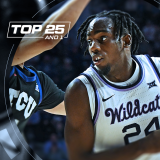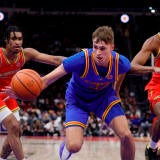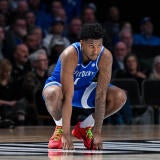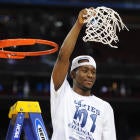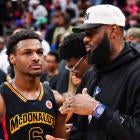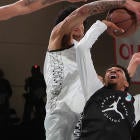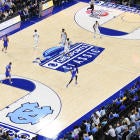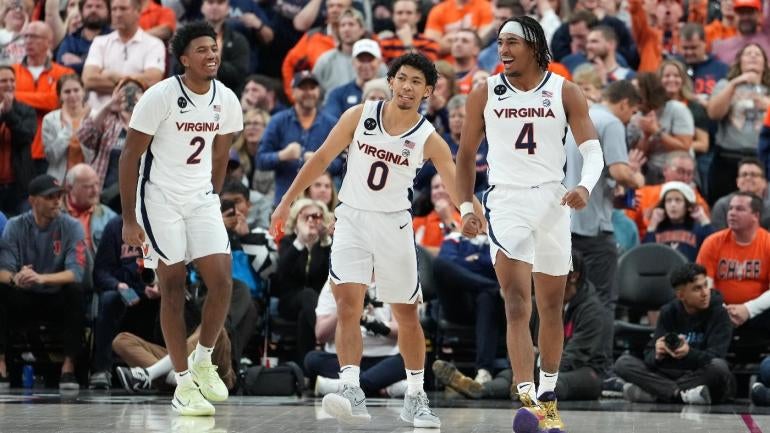
When Virginia was ranked 18th in the preseason AP Top 25, it was mostly thanks to the Cavaliers returning nearly 95% of their scoring from the past season.
But was all that returning experience a good thing? After all, last year, Virginia missed the NCAA Tournament for the first time since 2013, had major struggles scoring and -- unlike most of Tony Bennett teams of the past -- defending. But early returns this season say the age-old mantra of coaches wanting their teams to "get old and stay old" still applies. The Cavaliers beat then-No. 5 Baylor and then-No. 19 Illinois en route to winning the Continental Tire Main Event in Las Vegas, are No. 5 in the latest AP Poll and very much look the part of a top team. Here are three reasons why.
Armaan Franklin and the outside shooting
After losing its top four 3-point shooters from 2020-21, Virginia needed to replenish its outside shooting and called on Armaan Franklin. The Indiana transfer shot 42.4% from deep in his final season as a Hoosier. But Franklin plummeted to 29.6 percent in 2021-22, second-worst of any ACC player taking at least five 3-pointers per game, and the Cavaliers shot just 32.3% on 3-pointers, 257th in Division I, .
There was hope, though. While all eyes were on the NCAA Tournament, Franklin connected on 12 of 23 threes in the NIT after Bennett spotted "a little tiny mechanical thing" in his shot that needed adjusting. That "little tiny" change made a big difference then, and it's making a big difference now. Franklin is 10 for 22 so far this young season, and his shooting has been contagious. Entering Tuesday, Virginia ranked fourth in Division I at 46.9 percent from deep.
Notable Virginia 3-point shooting | This season | Last season |
|---|---|---|
50% (6-12) | 33.8% | |
50% (6-12) | N/A (in high school) | |
46.7% (7-15) | 34.6% | |
46.2% (6-13) | 33.8% (at Ohio) | |
Armaan Franklin | 45.5% (10-22) | 29.6% |
The sample size is obviously very, very small. Will Virginia continue to shoot nearly 47% from behind the arc? Probably not, considering no D-I team has shot that well in the past three decades. Again, these are extremely small sample sizes. But last season, Virginia had zero reliable 3-point shooters. This year, it has at least a few, even if every player listed above starts shooting worse than they are currently.
Still, Virginia went just 5 for 17 from 3-point range against Illinois but made up for it in another area that's been a big change this year.
Forcing turnovers and creating transition opportunities
Bennett's Virginia teams will never, ever be associated with a team that likes to run. The Cavaliers have always played at a plodding pace under Bennett, finishing outside the top 300 in KenPom.com's Adjusted Tempo metric every season. This season, they're 363rd -- dead last. But in an interesting development, the team is actually in transition more than ever under Bennett. According to Synergy, 12.8 percent of the Cavaliers' possessions have been in transition this season, twice the rate of last year's team.
This trend goes hand-in-hand with Virginia's surprising ability to create turnovers. The Cavaliers are forcing a turnover on 21.7 percent of opponent possessions, which, again, would be their highest under Bennett. This year Virginia has extended its defense at times, been more aggressive and active going for steals, and has been far more willing to get up and down the court when opportunities present themselves.
Taking better shots
The debate over what is a "good" shot has become increasingly fervent over over the past decade or so, but the general premise is this: Teams should shoot more at the rim or from beyond the 3-point line and less from midrange. You're more likely to make shots or get fouled at the rim than you are from midrange, and both shots count for two points. Furthermore, teams generally aren't so much better from midrange than from beyond the arc that it's enough to cover the fact that three points is worth more than two. The midrange is still important, especially in individual scoring, but it's becoming less valuable.
Here are Virginia's shooting splits each of the last two seasons, based on how often and how well the Cavaliers shoot from those areas, per Hoop-Math.
Virginia pct. of FGA and FG pct. by location | This season | Last season |
|---|---|---|
At Rim | 37.1% of FGA | 62.5 FG% | 35.5% of FGA | 58.4 FG% |
2-point Jumpers | 21.1% of FGA | 29.3 FG% | 34.5% of FGA | 41.9 FG% |
3-pointers | 41.8% of FGA | 46.9 FG% | 29.9% of FGA | 32.3 FG% |
Virginia is shooting more shots at the rim (and shooting slightly better from there) and shooting way more shots from beyond the arc (and shooting significantly better from there) than last year.
Last year, much of the offense ran through Jayden Gardner, and 60% of his shots were 2-point jumpers. Gardner was generally a solid and sometimes very good offensive player, but having to rely so heavily on midrange jumpers hurt Virginia's offensive ceiling. It had few other options, though, given the poor shooting at the rim and beyond the arc.
Entering the season, Bennett described his team as more versatile than last year's, and Ohio transfer Ben Vander Plas has made those words come true. Vander Plas has played both power forward and center, leads the team with a 147.6 offensive rating and has provided the stretch big man component that was sorely needed. Unlike Gardner, Vander Plas rarely shoots midrange shots -- just one of his 17 shots have been from there -- and his six 3-pointers through four games are already more than last year's bigs made combined all season (three).
In the first two clips, when two defenders cut off a Virginia dribbler, Vander Plas makes the defense pay with his spacing, movement and shooting. But the third clip -- in which Vander Plas doesn't even touch the ball -- helps show the full extent of his impact. Coleman Hawkins (No. 33) knows he can't help off Vander Plas given his shooting ability. That allows Beekman to operate one-on-one all the way to the basket and score, even against very good individual defense.
Because they're shooting better and shooting better shots, the Cavaliers entered Tuesday ranked 25th in Division I in effective field goal percentage -- which weighs the added value of a three -- this season. They were 220th last season.
A lot of Virginia's offensive improvement simply comes down to much better shooting. Basketball is a make-or-miss sport, after all, and the Cavaliers won't stay scorching hot forever. But even when those percentages come down, Virginia is finding more, better and more efficient ways to score, which bodes well moving forward.




